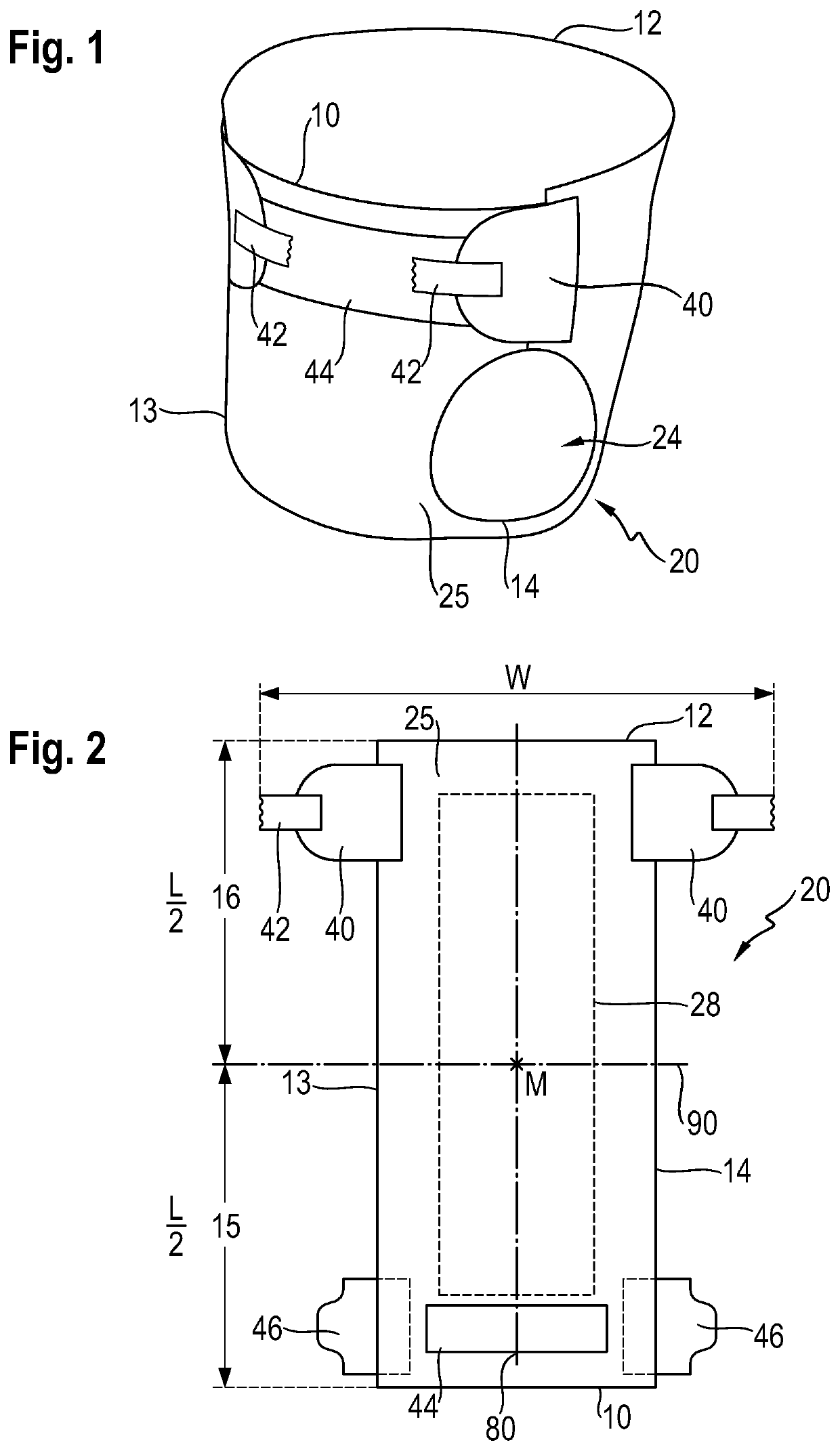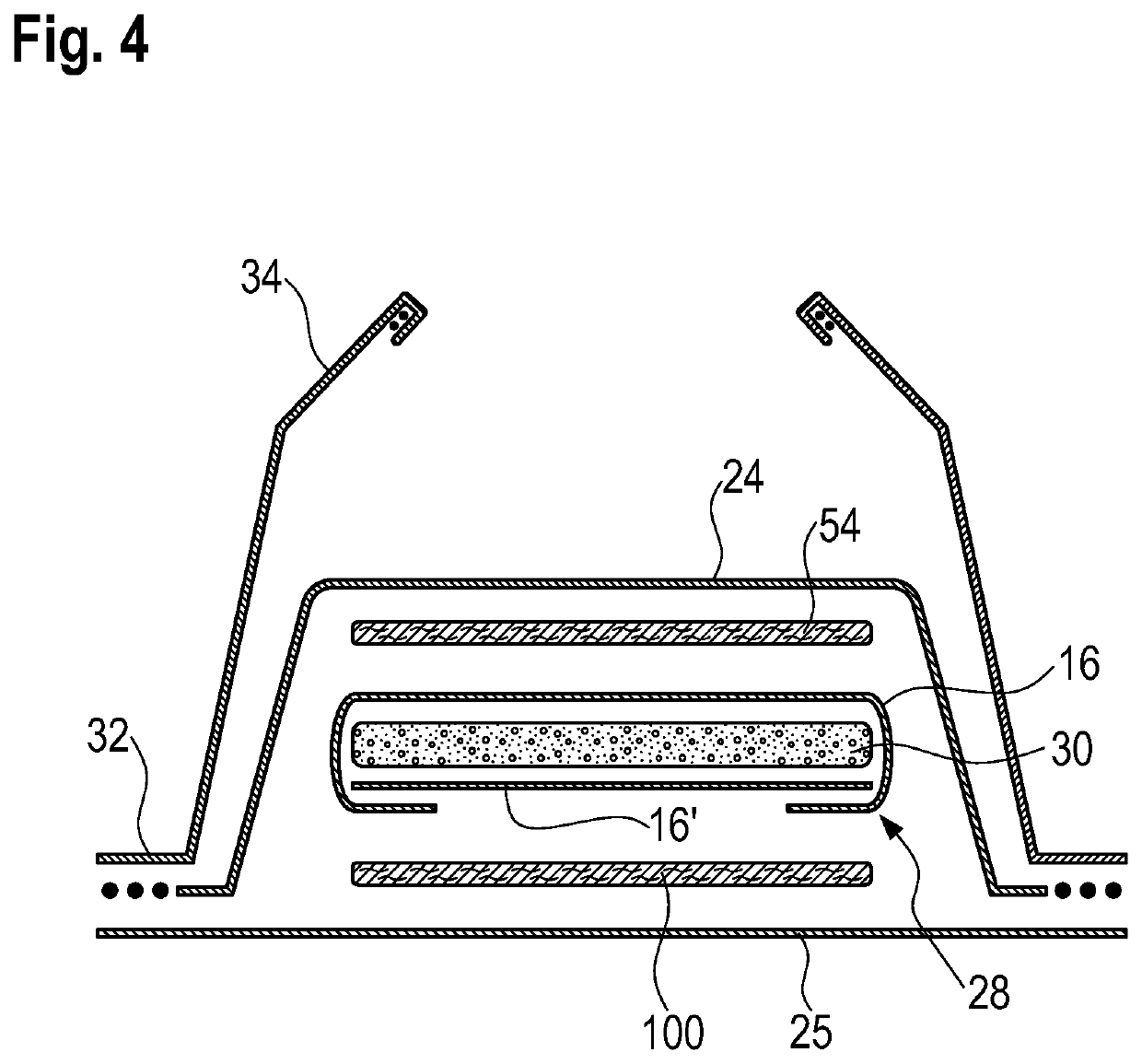Flexible and compliant mechanically-deformed nonwovens for use in absorbent articles
a nonwoven, flexible technology, applied in the field of nonwovens, can solve the problems of poor diaper appearance, grainy texture on the surface of the diaper, and relatively bulky mixed layers, and achieve the effect of adequate acquisition performan
- Summary
- Abstract
- Description
- Claims
- Application Information
AI Technical Summary
Benefits of technology
Problems solved by technology
Method used
Image
Examples
example 1
Nonwoven Comprising a Carded Nonwoven and an Airlaid Layer
[0074]
Precursor NW MaterialBi-layer material with:a 60 gsm airlaid nonwoven (3% latex,20% PP / PET bicopolymer, 77%cellulose fibers), anda 20 gsm PE / PP carded air-throughcarrier nonwovenPrecursor Horizontal14mm (for both sides)Bending Drop valuePrecursor Z-Compliance44.9mm3 / NIndexPrecursor Recovery77.7%Index
[0075]While this precursor has a relatively good Z-Compliance Index and Recovery Index, the precursor nonwoven has a very low Bending Drop Value and thus would make a diaper very stiff.
Treatment ANested Self treatment (as in FIG. 22 ofWO 2016 / 040101) with a DOE 2.5 mmHorizontal Bending91mm (protrusions facing upwards)Drop value after51mm (protrusions facing downwards)Treatment AZ-Compliance Index96.3mm3 / Nafter treatment ARecovery Index After48.3%treatment ACaliper at 0.85 kPa1.99mmAfter Treatment A
Treatment BSelf-on-Self treatment (as in FIG. 16 andfollowing of WO2012 / 148,944A1) with aDOE 3.0 mmHorizontal Bending91mm (Side 1...
example 2
[0077]
Precursor NW Material100 gsm MBAL airlaid nonwoven (5% Latex,19% PE / PET bicopolymer, 76% Cellulose)Precursor Horizontal17mm (for both sides)Bending Drop valuePrecursor Z-Compliance68.2mm3 / NIndexPrecursor Recovery76.9%Index
Treatment ANested Self treatment (as in FIG. 22 ofWO 2016 / 040101) with a DOE 2.75 mmHorizontal Bending84 mm (protrusions facing upwards, otherDrop value afterside was clearly lower but not measured)Treatment AZ-Compliance Index124.1mm3 / Nafter Treatment ARecovery index after50.8%Treatment ACaliper at 0.85 kPa2.62mmafter Treatment A
Treatment BSelf-on-Self treatment (as in FIG. 16 andfollowing of WO2012 / 148,944A1) with aDOE 3.0 mmHorizontal Bending90mm (Side 1 facing upwards)Drop value after89mm (Side 2 facing downwards)Treatment BZ-Compliance Index110.3mm3 / Nafter Treatment BRecovery index after60.7%Treatment BCaliper at 0.85 kPa after2.65mmTreatment B
[0078]This shows the same effect as for the first example above for a different class of material (MBAL). The De...
example 3
[0080]
Precursor NW MaterialA 110 gsm integrated spunlace nonwovencomprised of three carded strata havingthe following composition:Card 1 + Card 2 (37 gsm each):20% 1.7dtex CV40% 5.8dtex PET / PE40% 10dtex PET HSCard 3 (36 gsm):80% 1.7dtex CV20% 10dtex PET HSActivated with a temperature above 130 C.Precursor Horizontal60mm (for both sides)Bending Drop valuePrecursor Z-Compliance36.6mm3 / NIndexPrecursor Recovery79.5%index
Treatment ASelf-on-Self treatment (as in FIG. 16 andfollowing of WO2012 / 148,944A1) with aDOE 4.6 mmHorizontal Bending Drop83mm (Side 1 facing upwards)value after Treatment A86mm (Side 2 facing downwards)Z-Compliance Index145.5mm3 / Nafter Treatment ARecovery index after66.6%Treatment ACaliper at 0.85 kPa3.21mmafter Treatment A
Treatment BSelf-on-Self treatment (as in FIG. 16 andfollowing of WO2012 / 148,944A1) with aDOE 3.0 mmHorizontal Bending Drop90mm (Side 1 facing upwards)value after Treatment B87mm (Side 2 facing downwards)Z-Compliance Index77.5mm3 / Nafter treatment BReco...
PUM
| Property | Measurement | Unit |
|---|---|---|
| pressure | aaaaa | aaaaa |
| thickness | aaaaa | aaaaa |
| Height | aaaaa | aaaaa |
Abstract
Description
Claims
Application Information
 Login to View More
Login to View More - R&D
- Intellectual Property
- Life Sciences
- Materials
- Tech Scout
- Unparalleled Data Quality
- Higher Quality Content
- 60% Fewer Hallucinations
Browse by: Latest US Patents, China's latest patents, Technical Efficacy Thesaurus, Application Domain, Technology Topic, Popular Technical Reports.
© 2025 PatSnap. All rights reserved.Legal|Privacy policy|Modern Slavery Act Transparency Statement|Sitemap|About US| Contact US: help@patsnap.com



